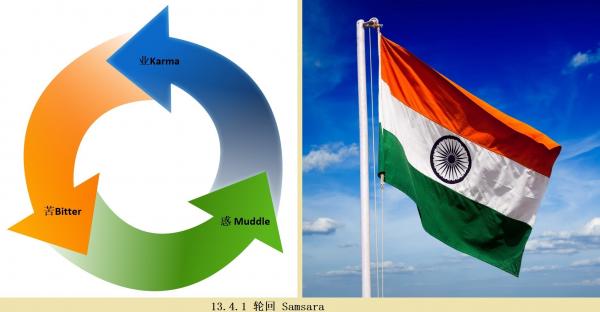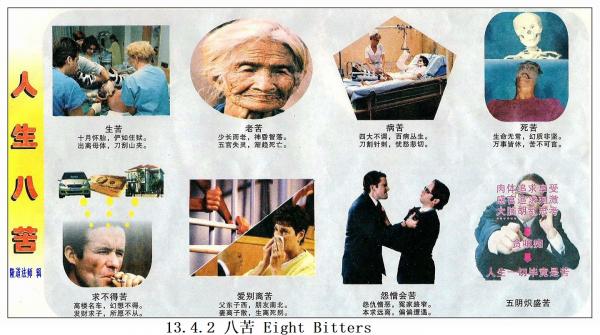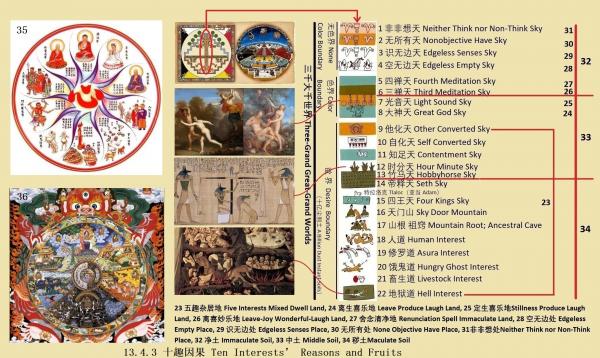| 13.4 統觀大千世界 General Views of Great-Grand Worlds |
| 送交者: 盧岩 2024年01月04日20:39:31 於 [茗香茶語] 發送悄悄話 |
|
總觀三千大千世界,可得,流轉,八種苦相,十趣因果,和25有。 Taking a general view of the Three-Grand Great-Grand Worlds, one can obtain the vicious cycle, eight bitterness, ten interests of causes and fruits, and 25 haves. 13.4.1 流轉 Cycle六趣有情遷流於三界九地之中,不得休息和出離,其因果不出十二有枝:無明、行、識、名色、六處、觸、受、愛、取、有、生、老死。 Sentient beings of the Six Interests drift among the three boundaries nine lands, their causes and fruits are among the twelve have branches: Non-Light (Ignorance), Migration, Sense, Name-Color, Six Places, Touch, Acceptance, Love, Fetch, Have, Birth, Old Death. 無明義為昏暗、想知道得清楚些,即是無知,從而引發了行枝的運動。此運動,或說由行枝引起的不同,就是識,就是識枝。雖說行枝和識枝同時而有,依據因果,把此二分了先後。就這樣,無明枝和行枝引發了後面五枝業果。 Non-Light means dim, and wanting to know, is Ignorance, so that causes the Migration Branch to move. Differences caused by Migration Branch are Senses, are Sense Branch. Although the Migration Branch and Sense Branch come into existence at the same time, based on cause and effect, we divide these two into successive stages. In this way, the Non-light Branch and Migration Branch trigger the next five fruits branches. 識、名色、六處、觸、和受,五枝被稱作五果,義為它們過去業習氣果的現行。識枝把信息傳播到了名色枝。名即四無色蘊, 即受蘊、想蘊、行蘊、和識蘊,色即色蘊;名和色合在一起就是心,但此時心並不明了,只能說是識正把信息向有情身心擴散。明是明白、內明的光明。當六處收到信息後,由於先業的作用,心開始形成,所以觸枝顯現了。觸(參見11.4.4.1.1節)是遍行心所有法的觸枝,有類似於心的功能,可以為心的形成提供動力。當六處明了,受枝就出現了。受枝遇痛則死;若遇到可愛果,受會招引位於三界九地的同類法來攝取可愛果。受枝出現之後,心就變得明了了。一而再,再而三,就引發了後面的孕育三枝。 The five branches of Sense, Name Color, Six Places, Touch, and Acceptance are called Five Fruits, meaning the fruitful performances of their past karmic habits. The Sense branch transmits information to the Name Color Branch. Names are the four colorless nodes, i.e., acceptance node, think node, migration node, and sense node; Color is color node. Name and Color together are the heart, the flesh body and mind, but at this point, the heart is not illuminated yet; it can only be said that the Senses are spreading the information to the heart, i.e., the flesh body and mind. Illumination is saying of internal light, light of enlightenment. After Six Places (Cf. section 11.3) receive the information, due to karma, heart starts to form, therefore a similar heart, Touch Branch arises. Touch is an Omnipresent Heartland Laws (Cf. section 11.4.4.1.1), can provides heart power during heart formation. After the Six Places are illuminated, the Acceptance Branch appears. When Acceptance Branch encounters pain, it dies; if it encounters lovely fruits, can summon similar laws located in the three boundaries and nine lands. After the emergence of the Acceptance Branch, the heart is fully illuminated. Repeatedly and again, it triggers the later three gestation branches. 愛、取、有三枝可以孕育有情,所以被古人稱作能生枝。可愛果是異熟果(參見11.6.1節),稀少,像是農業產品,數量有限;而受枝的享受者是等流果。等流果易招,異熟果難求,進而愛生。愛是肥水,能孕育萬物,會導致取枝的出現。一而再,再而三,有枝就出現了。什麼是有?記憶有,習氣有就是有。有枝會導致後面的生枝和老死枝。 The three branches of Love, Fetch, and Have can give birth to interests, and so they were called three gestation branches by Ancient Virtues. Lovable fruits are mutant fruits (cf. Section 11.6.1), scarce, like agricultural products, limited in quantities; and the enjoyers of the Acceptance Branch are equal-stream fruits. Equal-stream fruits are easy to summon, but mutant fruits are hard to get, therefore Love Branch emerges. Love is fertile water, can brew anything, therefore Fetch Branch emerges. More, and again, Have Branch is formed. What is the have? Having memory and having habit are haves. Have Branch can induce later branches of Birth and Old Death. 生支和老死枝是被前文的能生支引發的。從無到有為生。衰敗為老。滅絕為死。死不一定出現,所以古人用老死來建立此枝。前習氣已被孕育了,這出生就是必然的了,隨後就有了愁、嘆、苦、憂、惱、老死。 The Birth Branch and Old Death Branch are induced by the preceding gestation branches. From nothing to something is birth. Decay or deterioration is old. Extinction is death. Death does not necessarily arise, so the ancients used old-ness and death together to establish this branch. The former habit having been conceived, this Birth is inevitable, followed by sorrow, sighing, bitterness, worry, anguish, and old death. 十二有支亦惑業苦三輪來攝取。惑攝無明支、愛支和取支。業攝行支和有支。苦攝識、名色、六處、觸、受、生和老死。名色、六處、觸、受和識即是有情身心;生死是有情的煩惱。因此苦輪所攝就是苦海中的眾生。這樣,這十二有支的因果循環,就變成了:眾生受苦起惑,因惑起行造業,業又生苦;如是惑業苦循環無盡。 The twelve have branches can also be assimilated by a Wheel composed of Muddle Karma and Bitter. Muddle assimilates Non-light, Love, and Fetch. Karma assimilates Migration and Have. Bitter assimilates Sense, Name Color, Six Places, Touch, Acceptance, Birth, and Old Death. Name Color, Six Places, Touch, Acceptance, and Sense are sentient beings' bodies and minds. Birth and Death are sentient beings' annoyances. Thus, the Bitter takes in all sentient beings in the bitter sea. In this way, the cycle of cause and fruit of these twelve have branches becomes: sentient beings receive bitter to create muddles, and because of muddles they create karma, and karma gives rise to bitter; so, the Wheel of Muddle Karma and Bitter is rolling itself ceaselessly.
此十二有枝,古人稱作十二緣起,亦作流轉真如,是佛教中的七真如之一。契經中是這樣描述的:無明望行、行望識、識望名色、名色望六處、六處望觸、觸望受、受望愛、愛望取、取望有、有望生、生望老死,起愁嘆苦憂惱,成大苦具。 These twelve have branches, which the Sanskrit word is pratītya-samutpāda-aṅga, also known as Samsara True-Suchness, is one of the seven kinds of true suchness in Buddhism. The harmonious sutra describes it like this: Non-Light watches Migration, Migration watches Sense, Sense watches Name-Color, Name-Color watches Six Places, Six Places watch Touch, Touch watches Acceptance, Acceptance watches Love, Love watches Fetch, Fetch watches Have, have watches Birth, Birth watches Old Death, arise a great worry, sighing, bitter, gloomy, a great annoying aggregate is formed. 13.4.2 八苦 Eight Bitterness (一)生苦,事物從無變有為生;新事新物總是不斷地出現,令人身心生起種種的苦受。 (二)老苦,事物變異衰敗為老;事物總是不斷地變老變壞,令人身心生起種種的苦受。 (三)病苦,新舊事物老是出毛病,起衝突,令人身心生起種種的苦受。 (1) Birth Bitter, birth means from none to have; new things are always appearing, causing kinds of bitter acceptances in the body and heart. (2) Old Bitter, old means deterioration, decay; things are constantly deteriorating, causing kinds of bitter acceptances in the body and heart. (3) Illness Bitter, often getting diseases, causing kinds of bitter acceptances in the body and heart.
(四)死苦,事物從有變無為死;已有的事物總是不斷地消失永別,令人身心生起種種的苦受。 (五)怨憎會苦,心目中常時怨恨憎惡的壞人,希望他長時遠離,但偏與之有集聚會合。 (六)愛別離苦,自己親愛的人事物,希望常相聚會,但偏有違緣逆境,使其分散。 (4) Death Bitter, that means things from haves to none; things that already have often disappear, giving rise to kinds of bitter in the body and heart. (5) Bitter of Meeting with the Grudges and Hatred; those bad people whom one always grudges and hates in mind, wishing that he or she would stay away for a long time, but often meeting with them. (6) Bitter of Separation from Love, in which people and things dear to one's heart, wishing to be together with them, but there are contrary causes and adversities that cause them to be scattered. (七)求不得苦,對於世間希求想得的財物、名位,及一切心中所愛樂的事物而不能有。 (八)五蘊勝苦,五蘊(參見11.4節)的生長繁榮昌盛,衰敗凋零枯竭,世事變遷,增減不定,令人身心生起種種的苦受。 (7) Bitter from can not be owned, not getting those assets and fames which mundane beings wish and strive to own, and those lovable laughable affairs in heart can not be owned. (8) Bitter from the Five Nodes are victorious, Five Nodes (cf. section 11.4) grow prosperous and flourishing, and they deteriorate and deplete, the mundane affairs are changing, the increase and decrease are uncertain, giving rise to kinds of bitter in the body and mind. 前八種苦相可以被總結為三種苦性:苦苦、壞苦、行苦。前五種苦是新苦遇舊苦,苦水流出,故苦,所以被命名為苦苦;這是苦的自性。知道了苦的自性,遇到苦時,不要再追憶創傷,避免苦泉的噴發。 The proceeding eight kind of bitter phenomena can be summarized as the three types of bitter natures: bitter-bitter, damage bitter, and migration bitter. The first five types of bitter are new bitter meeting old bitter, bitter water flowing out, hence bitter, therefore are named as Bitter-Bitter, which are self-nature of bitter. Knowing the self-nature of bitter, when one encounters bitter, should not tracing recall old trauma, so to avoid the eruption of bitter fountain. 八苦中,(六)愛別離苦和(七)求不得苦,是由得樂之後,樂變壞形成的,所以叫做壞苦;這是苦的自相。此苦來源於辨別,不辨別不就沒了。 Of the Eight Bitter, (6) bitter of separation from Love, and the (7) bitter from can not be owned, are formed by the deterioration of happiness after it has been attained, and are therefore called Damage Bitter, which is the self-phenomena of bitter. This bitter comes from discrimination; without discrimination it is not. 八苦的最後一項是五蘊勝苦,是由意(即前意識)不斷遷流變動形成的,所以叫做行苦。行苦的行是苦因,或者說是苦根。行即是遷徙,漂流的意思。佛教定義有思想活動,就是有行,即有行苦。這行苦的定義使三界九地,除了無所有處天,都有行苦。又四大種中,識是水,所以 “三千大千世界” 就立刻沉沒於苦海了。苦諦就這樣被建立了,所以苦諦安立真如。 The last of the Eight Bitters is the Bitter from the Five Nodes are victorious, which is formed by the constant migration of Intent, which is preconsciousness, also known as Eve-sense, is therefore called Migration Bitter. Migration is the cause of the bitter, or the root of the bitter. Buddhism defines whatever having mental activities as having Migration, then there are Migration Bitter. This definition of Migration Bitter makes the Three Boundaries Nine Land, except “No Objective Have Sky”, all have Migration Bitter. And of the four big seeds, sense is water (cf. section 11.2), so the “Three-Grand Great-Grand Worlds” immediately sink into bitter sea. Like this, Bitter Crux is established, therefore Bitter Crux is Establishment True-Suchness. 13.4.3 十趣因果 Ten Interests’ Reasons and Fruits 總觀三千大千世界中的三界九地,可得十趣因果。 一)嗔恚邪淫,即地獄業,極苦無間,即地獄果。 二)愚痴暗蔽,即畜生業,昏鈍困苦,即畜生果。 Summarizing the three boundaries nine lands in the three-grand great-grand worlds, one can obtain ten interests' reasons and fruits. 1) Irritation hate and heretical sexual conduct are hell karma, extremely bitter without intermittent rest, i.e., hell fruit. 2) Foolishly ignorance and gloomily concealment are livestock karma, gloomily dull and difficult bitter, i.e., livestock fruit. 三)慳貪不施,即餓鬼業,缺乏不遂,即餓鬼果。 四)我慢貢高,即修羅業,戰鬥爭奪,即修羅果。 五)堅持五戒,即人道業,苦樂夾雜,即人道果。 3) stingy, greedy, and no donation are hungry ghost karma, short of supplies and failure, i.e., hungry ghost fruit. 4) I (i.e., Seth, cf. section 11.4.4.1.4) arrogance and lifting oneself high are asura karma, combat expostulation and robbery, i.e., asura fruit. 5) adhere to the five precepts, are human karma, interlaced with bitter and laugh, i.e., humanity fruit. 六)精修十善,即天道業,享受福樂,即欲天果。 七)知緣性離,即緣覺業,證因緣覺,即緣覺果。 八)證悟人空,即小乘業,證小涅槃,即羅漢果。 6) diligently cultivating the ten benevolences are sky-path karma, enjoying acceptances of fortune and laugh, i.e., desire sky fruit. 7) knowing aggregate-arousal (cf. section 14.1) off nature is “aggregate-arousal perception” karma, proving causes of aggregate arousal, i.e., “aggregate-arousal perception” fruit. 8) testified and realized that human is empty, are small vehicle fruit, testament on small nirvana, i.e. Ararat fruit. 九)渡行齊修,即大乘業,漸入覺位,即菩薩果。 十)真慈平等,即神佛業,成圓覺滿,即神佛果。 9) practicing both cultivation and salvation, are great vehicle karma, gradually entering enlightenment position, i.e., bodhisattva fruit. 10) true mercifulness and even equality are God Buddha karma, perfect achievement, and full enlightenment, i.e., God Buddha Fruit.
13.4.4 二十五有 25 Haves 三界九地總言十趣因果(如圖13.4.3-35、36所示),別言25有。有即記憶有,業習氣有,因果不忘。欲界中的地獄趣、畜生趣、餓鬼趣,這三惡趣為3有。修羅趣為1有;人趣的四洲為4有;六欲天為6有,所以欲界總計14有。色界中的神眾天和神輔天為1有;大神天為1有;光音天中的三天為1有;三禪中的三天為1有;四禪中的前三天為1有,無想天為1有,五不還天為1有,所以色界總計為7有。無色界的四天各為1有。如是,三界九地總計為25有;此25有人人都有。 The three boundaries nine lands, generally to say, are ten interests of reasons and fruits (see fig. 13.4.3-35, 36), another saying, are 25 haves. Memory haves, habitual haves, causes vs. fruits are not forgotten, are haves. In desire boundary, hell interest, livestock interest, and hungry ghost interest, the three ferocious interests (fig. 22, 21, and 20) are three haves. Asura interest (fig. 19) is 1 have; the four continents of humanity are 4 haves; six desire skies are 6 haves; therefore, the desire boundary totally has 14 haves. In color boundary, godly crowds sky and godly assistant sky are counted as 1 have; the three skies in light sound sky are counted as 1 have; three skies in third meditation sky are counted as 1 have; the first three skies in fourth meditation sky are counted as 1 have; longevity sky is 1 have; five No Return Skies are 1 have; so that color boundary totally counts as 7 haves. The four skies in colorless boundary, each count as 1 have. Thus, three boundaries nine lands are counted as 25 haves in total, which everybody has. ↪️返回第13章《苦諦》的目錄↪️Back to Catalog of Chapter 13 Bitter Crux |
|
|
|
|
 |
 |
| 實用資訊 | |
|
|
|
|
| 一周點擊熱帖 | 更多>> |
|
|
|
| 一周回復熱帖 |
|
|
|
|
| 歷史上的今天:回復熱帖 |
| 2023: | “遠東特區”遐想(瞎想) | |
| 2023: | 他們弄醒了很多會消滅他們的人。 | |
| 2022: | ZT: 研究發現31光年外由鐵構成的系外行 | |
| 2022: | 王滬寧向何處去? | |
| 2021: | 警告海外中國人。東南亞南洋血腥排華死 | |
| 2021: | 台灣防疫經歷 | |
| 2020: | 羊城隨記 - 就診篇 | |
| 2020: | ||
| 2019: | 真實牛皮,月亮上沒水,潮汐如何讓月亮 | |
| 2019: | 附加題:為什麼汽車不安裝換道支持系統 | |






